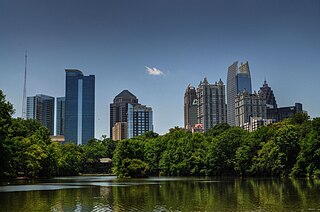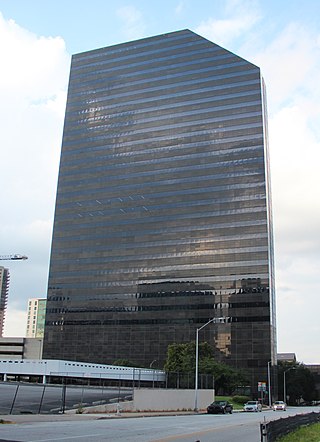
Midtown Atlanta, or Midtown, is a high-density commercial and residential neighborhood of Atlanta, Georgia. The exact geographical extent of the area is ill-defined due to differing definitions used by the city, residents, and local business groups. However, the commercial core of the area is anchored by a series of high-rise office buildings, condominiums, hotels, and high-end retail along Peachtree Street between North Avenue and 17th Street. Midtown, situated between Downtown to the south and Buckhead to the north, is the second-largest business district in Metro Atlanta. In 2011, Midtown had a resident population of 41,681 and a business population of 81,418.

Buckhead is the uptown commercial and residential district of the city of Atlanta, Georgia, comprising approximately the northernmost fifth of the city. Buckhead is the third largest business district within the Atlanta city limits, behind Downtown and Midtown, and a major commercial and financial center of the Southeast.

Atlanta History Center is a history museum and research center located in the Buckhead district of Atlanta, Georgia. The Museum was founded in 1926 and currently consists of nine permanent, and several temporary, exhibitions. Atlanta History Center's campus is 33-acres and features historic gardens and houses located on the grounds, including Swan House, Smith Farm, and Wood Family Cabin. Atlanta History Center's Midtown Campus includes the Margaret Mitchell House & Museum. The History Center's research arm, Kenan Research Center, is open by appointment, and provides access to the archival collections. Atlanta History Center holds one of the largest collections of Civil War artifacts in the United States.

Lenox Square is a shopping mall in the Buckhead district of Atlanta, Georgia. With 198 tenants and 1,558,678 square feet (144,805.9 m2) of gross leasable area, it is the third-largest mall in Georgia. The mall is currently owned and managed by Simon Property Group, and is considered a sister mall to the adjacent, Simon-owned Phipps Plaza. The mall features Macy's, Bloomingdale's, and Neiman Marcus.
Garden Hills Elementary School is an elementary school in Garden Hills, Atlanta, Georgia and a part of Atlanta Public Schools (APS).

Hickory Hill, also known sometimes as the Thomas E. Watson House, is a historic house museum at 502 Hickory Hill Drive in Thomson, Georgia. A National Historic Landmark, it was a home of Georgia Populist Party co-founder Thomas E. Watson (1856-1922). The main house was added to the National Register of Historic Places (NRHP) in 1976 (#76002144) and the whole site was added to the NRHP in 1979 (#79003110).

Salesforce Tower Atlanta is a 425 ft (130m) tall skyscraper in Atlanta, Georgia. It was completed in 1986 and has 34 floors. Smallwood, Reynolds, Stewart, Stewart & Associates, Inc. designed the building, which is tied with 1100 Peachtree as the 25th tallest building in Atlanta. A second tower with the same profile, but boasting ten additional floors, and a four-hundred-room hotel were originally planned for the surrounding site but never built.

The Waldorf Astoria Atlanta Buckhead is a 580 ft tall combination hotel/condominium building skyscraper in Atlanta, Georgia. It was constructed from 2006 to 2008 and has 42 floors. It is the 12th tallest building in Atlanta and the fifteenth tallest residential highrise in the United States. The design architect for the building was Robert A.M. Stern Architects with Atlanta firm Milton Pate Architects serving as the Architect of Record. The project was developed by Atlanta-based City Centre Properties, LLC and constructed by Holder Construction Company.

The T. R. R. Cobb House built in 1842 is an historic octagon house originally located at 194 Prince Avenue in Athens, Georgia. On June 30, 1975, it was added to the National Register of Historic Places.

The Academy of Medicine in midtown Atlanta, Georgia, was built in 1941 and housed the Medical Association of Atlanta until the 1970s. The building is listed on the National Register of Historic Places, and is also designated as a historic building by the City of Atlanta. It is currently owned by the Georgia Institute of Technology.

The Edward Inman "Swan" House is a mansion in Atlanta, Georgia. It was designed by Philip T. Shutze and built in 1928 for Edward and Emily Inman. The house is currently part of the Atlanta History Center, and it has been featured in The Hunger Games: Catching Fire and The Hunger Games: Mockingjay, Part 2.
Cecil Abraham Alexander, Jr. was an American architect, principally a designer of commercial architecture, best known for his work in Atlanta, Georgia. He worked with the firm FABRAP, which, in 1985, became Rosser FABRAP International and later Rosser International. Together with other architects of the firm, he "shaped the skyline of Atlanta".

Philip Trammell Shutze was an American architect. He became a partner in 1927 of Hentz, Adler & Shutze. He is known for his neo-classical architecture.

The Paramount Theatre was a movie palace in downtown Atlanta, Georgia, United States. The building was designed by Philip T. Shutze and was completed in 1920 as the Howard Theatre, a name it kept until 1929. It was located at 169 Peachtree Street, in an area that soon became the location of several other major theaters, earning it the nickname "Broadway of the South". With a seating capacity of 2,700, it was at the time the second largest movie theater in the world, behind only the Capitol Theatre in New York City. In addition to functioning as a movie theater, the building hosted live performances, with several nationally renowned orchestras playing at the venue through the 1940s and Elvis Presley playing at the theater in 1956. By the 1950s, however, movie palaces faced increased competition from smaller movie theaters and the rise in popularity of television, and the Paramount was demolished in 1960.
North Fulton High School was a high school in northern Atlanta, Georgia. It was a part of Fulton County Public Schools and then Atlanta Public Schools. It merged into North Atlanta High School in 1991. The building now houses Atlanta International School.

Piedmont Avenue is a major thoroughfare in Atlanta, beginning in Downtown Atlanta and ending at its continuation as Piedmont Road just before crossing under Interstate 85. Along the way, Piedmont Avenue passes through Midtown Atlanta where several historic properties are located on the street.

The Atlanta Financial Center (AFC) is a 914,747-square-foot office building complex located in Buckhead, Atlanta, Georgia. The office complex is situated directly over the Georgia 400 highway and features a black aluminum/glass-frame design, composed of three interconnected towers: an 11-story South Tower, a 12-story North Tower and a 19-story East Tower. The Atlanta Financial Center is situated next to MARTA's Red Line Buckhead station; the Red Line runs directly underneath the complex.
Daniell and Beutell was an architectural firm in Atlanta during 1919 to 1941. It was a partnership of Sydney S. Daniell and Russell L. Beutell (1891-1943). They designed various government buildings, theaters, and residences. During the 1930s they focused on design of schools and health clinics.
Alexander F. N. Everett, also known as A. F. N. Everett, was an American architect who designed many buildings in his hometown of Atlanta, Georgia, including some listed on the National Register of Historic Places.

200 Peachtree is a mixed-use retail center in downtown Atlanta, Georgia designed by Philip T. Shutze and Starrett & van Vleck. Built in 1927 as the flagship department store for Davison's, the last department store in the building closed in 2003. The building later underwent an extensive renovation in the 2010s.

















